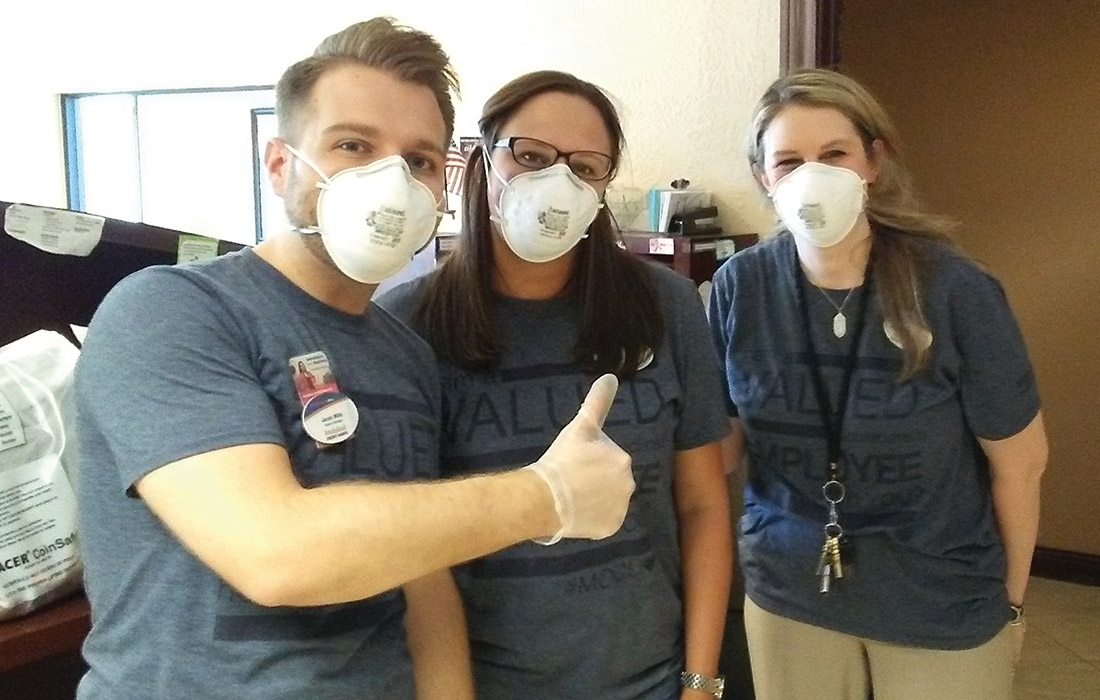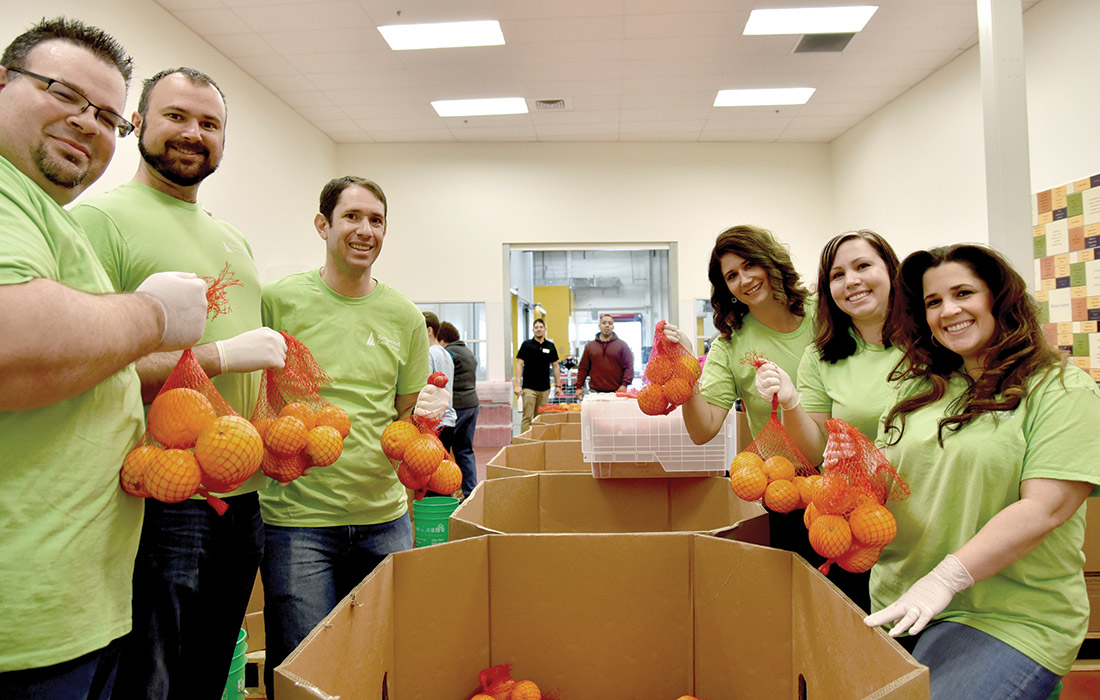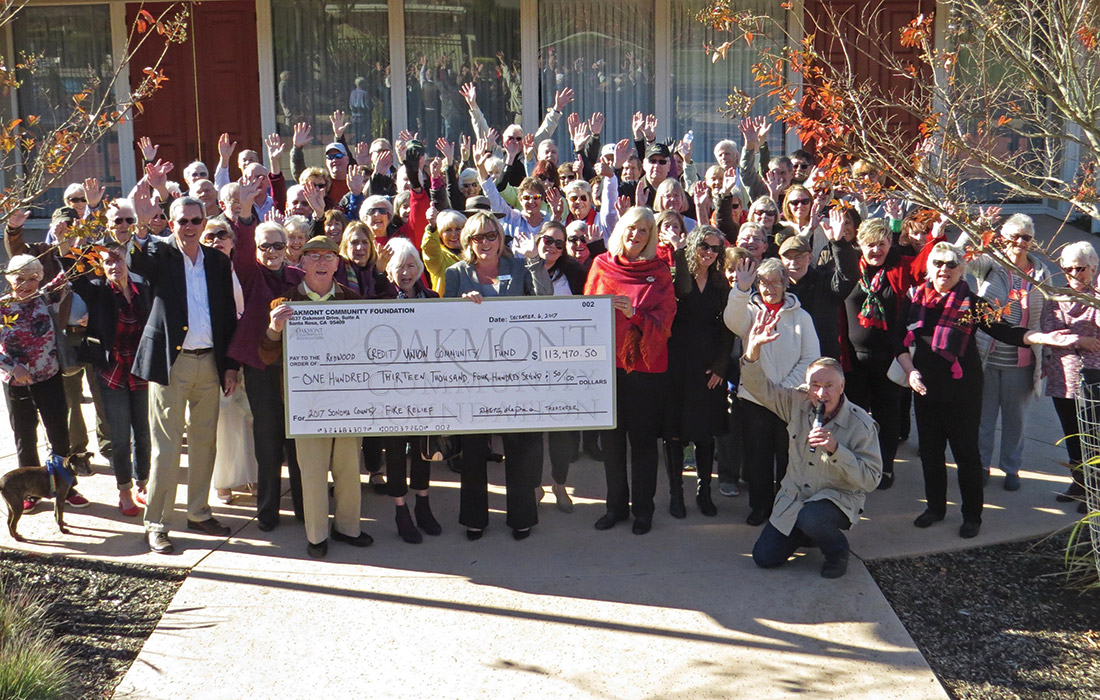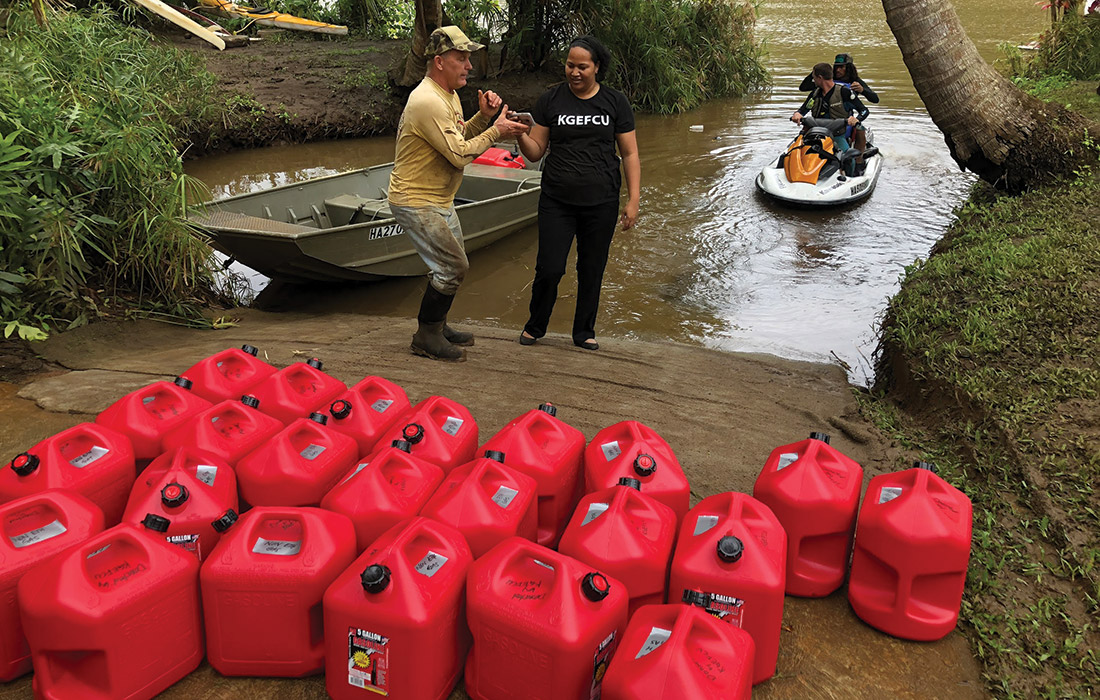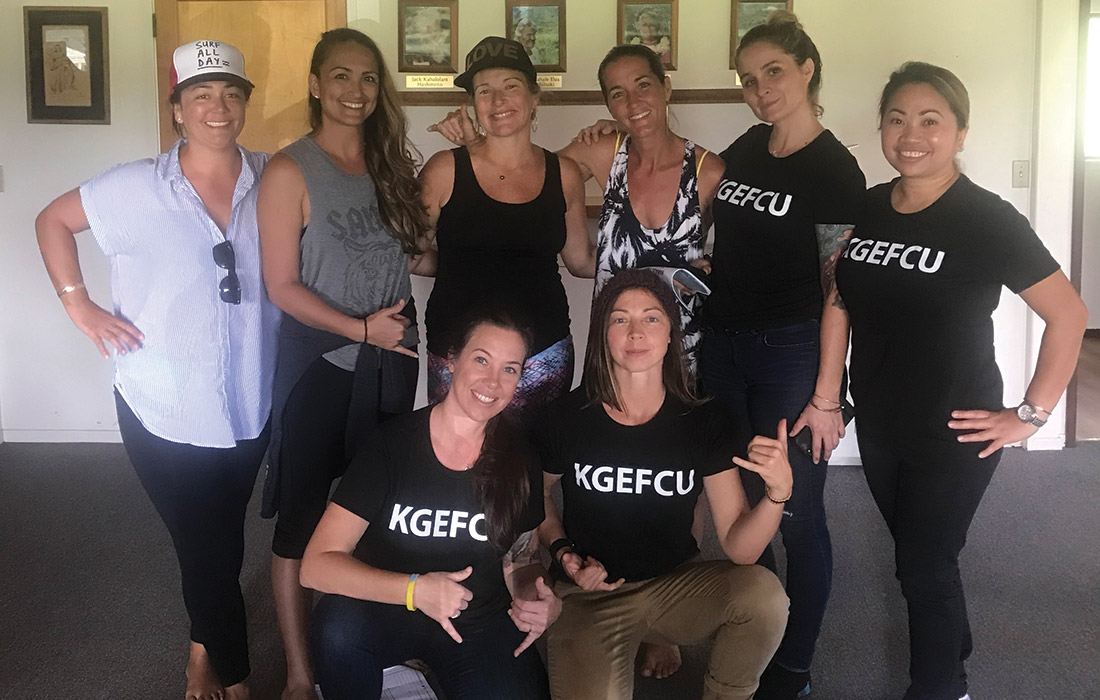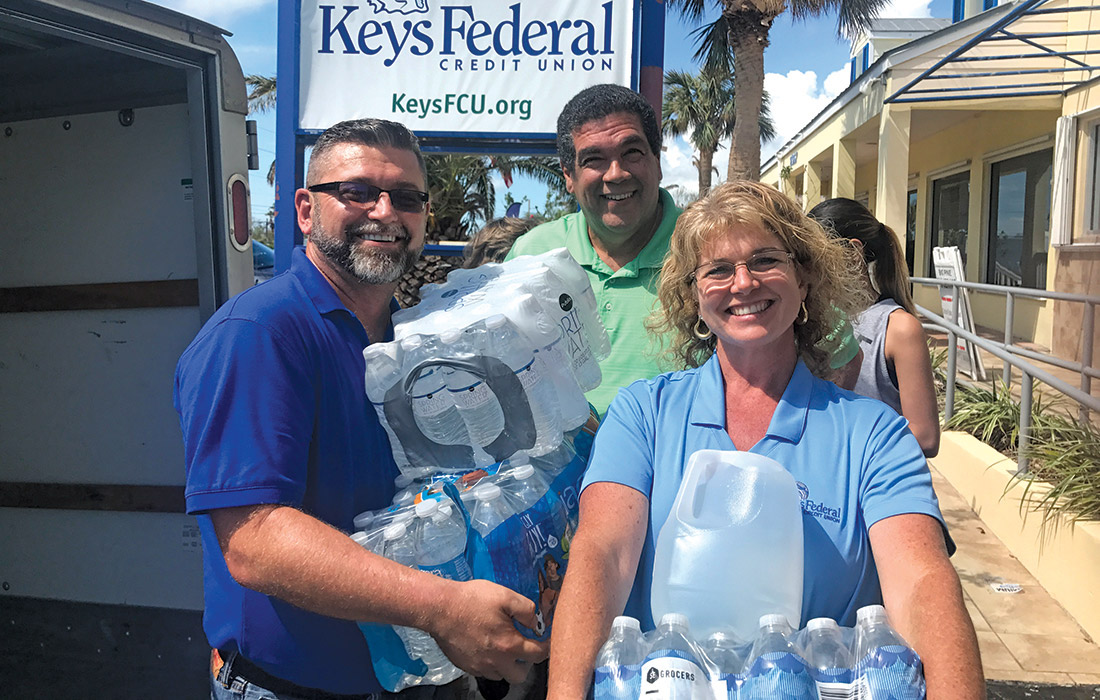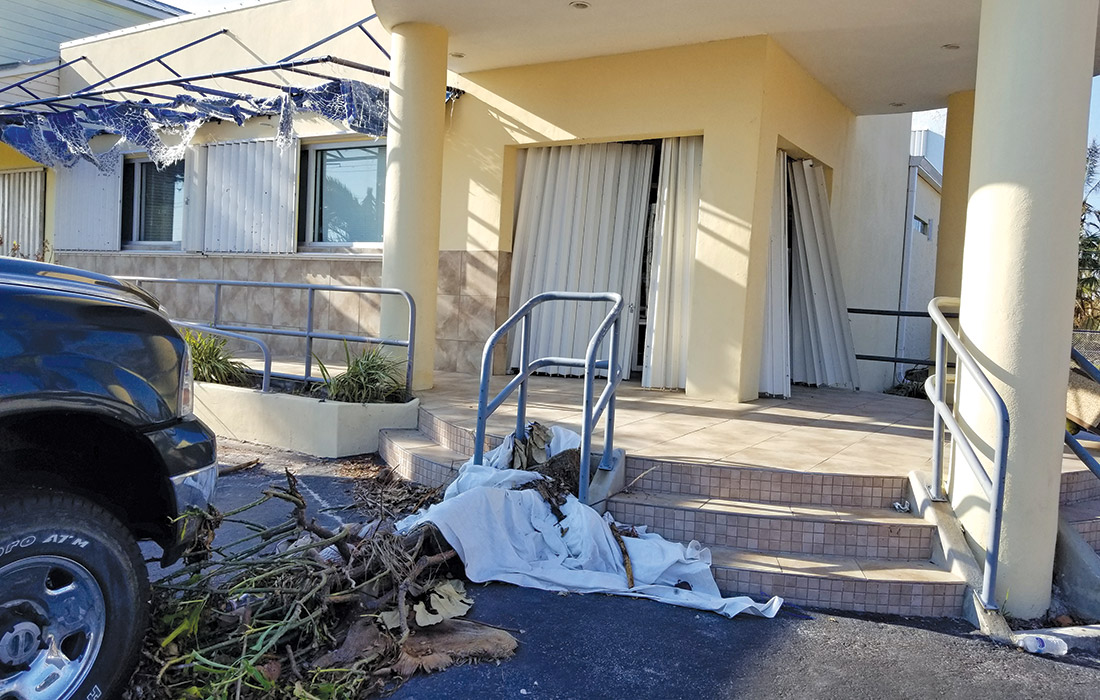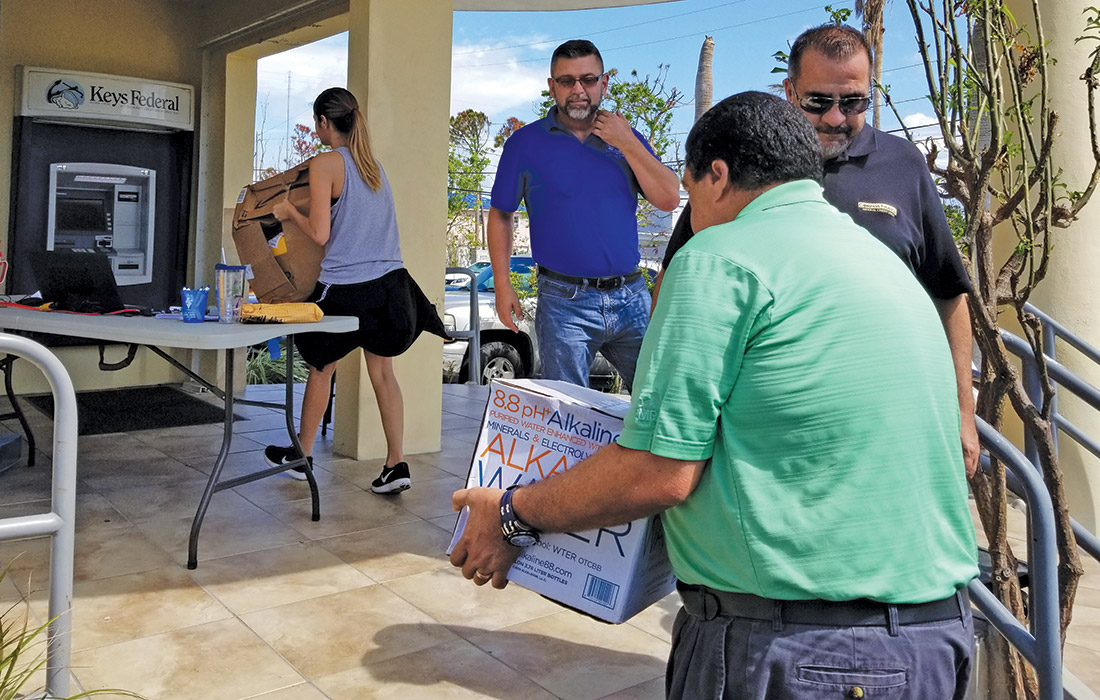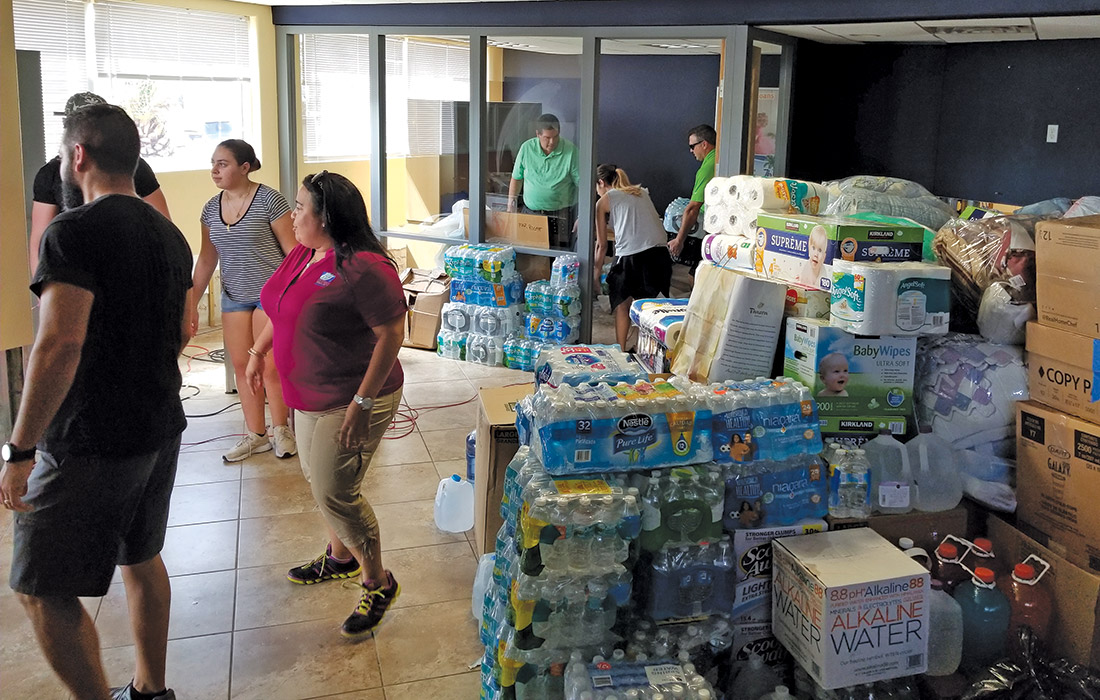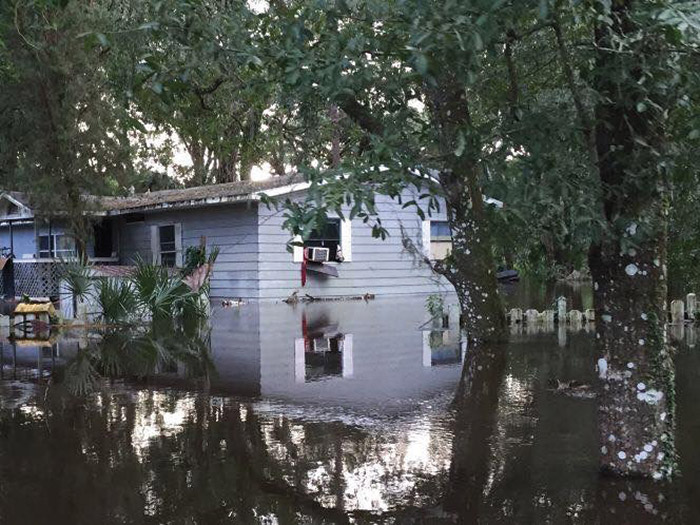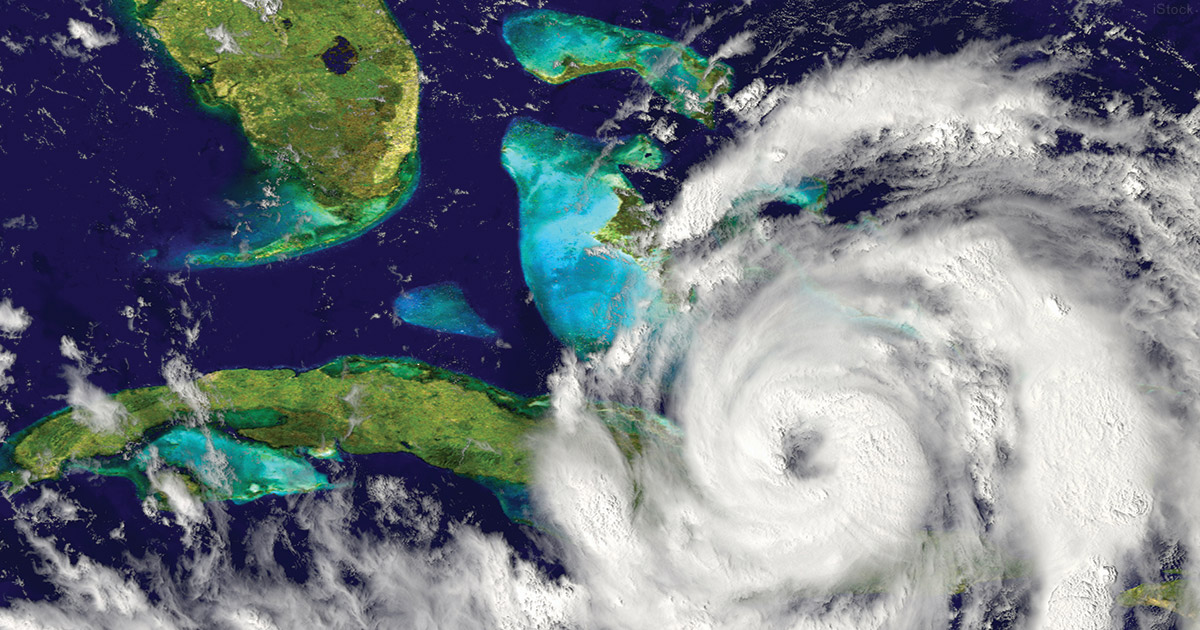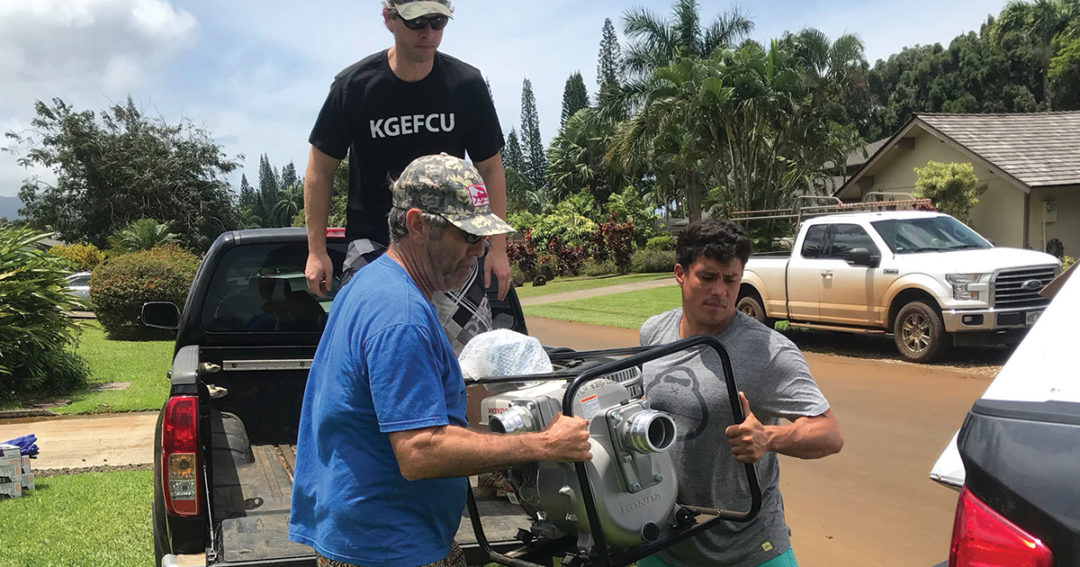
Disaster Lessons Learned
What works and what matters in disaster recovery.
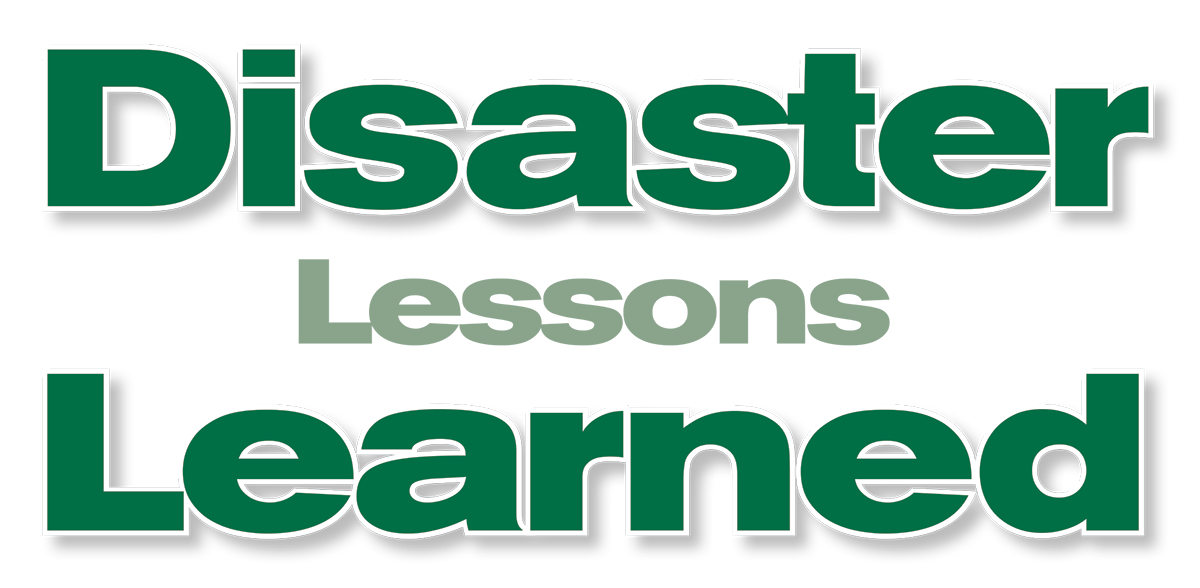
What works and what matters in disaster recovery.
Focus
- Keep staff in mind when planning for potential disasters.
- Consider using a third-party texting app that sends messages when cellular networks are down.
- Board focus: Review and practice your business continuity plan regularly.
If you wanted a learning lab for credit union disaster recovery, last year’s hurricanes, floods, and wildfires provided vital lessons about what works—and what matters—when credit unions come to the aid of their staff, members, volunteers, and communities.
Keep employees afloat
Credit union branches hit by wide-ranging disasters in 2017 were out of service from as little as a few hours to as much as two weeks or more.
In Beaumont, Texas, post-Hurricane Harvey rainfall topped 60 inches in five days. Mold quickly bloomed to make soaked houses uninhabitable.
At $780 million asset Mobiloil Federal Credit Union, 12 employees lost homes. Volunteers from the “Cajun Navy”—a group of Louisianans with boats who ferried people to safety in the wake of the storm—rescued Shane Perkins, Mobiloil’s programming and development manager, his pregnant wife, 18-month-old daughter, and two dogs from their flooded home.
Perkins was among the 85 employees, out of a total workforce of 175, who quickly returned to work to keep all branches and electronic services running. When one branch developed mold, Mobiloil Federal leased a closed bank branch to replace it, President/CEO Bob Hamer says.
If employees couldn’t reach their assigned branch, they shifted to another site. Supervisors kept schedules flexible while employees dealt with damaged homes and rearranged lives.
All employees, including those who were absent, were paid for the first two weeks post-disaster without using paid time off. As flood waters receded, Mobiloil Federal gave each employee an extra $1,000 for unexpected expenses and rewarded outstanding staff efforts with another $500 to $1,000.
Hamer says paying employees throughout the disaster cost a month’s worth of credit union earnings, but all employees stayed. “That’s the real testament to their resilience,” Hamer says.
Offer practical assistance
At $4.5 billion asset Redwood Credit Union in Santa Rosa, Calif., most employees were evacuated from their homes during the North Bay fires in Sonoma, Napa, Mendocino, and Lake counties. Credit union systems and services were spared even as 23 employees lost homes.
“We did a lot to immediately support our staff, officials, members, and community, and are continuing to help those who lost homes,” says CEO Brett Martinez.
Redwood’s assistance included:
- Financial support for employees and board members who lost homes.
- Temporary lodging for displaced employees and officials.
- Temporary child care for employees while schools were closed, with board members volunteering hands-on help.
- Industrial air purifiers and masks for employees to counter poor air quality.
- Free onsite counseling and expanded employee assistance program services.
- The ability for staff to pool surplus paid time off for co-workers who lost homes.
Here is a Podcast with photo.
CUNA News Podcast

Serving members through California wildfires
Sierra Central Credit Union’s John Cassidy explains how the credit union responds to disasters.
Here is a Podcast without photo.
CUNA News Podcast
Modern marketing with Louisiana FCU’s Mia Perez
Focus your brand promise on the member journey.
CUNA News Podcast
Modern marketing with Louisiana FCU’s Mia Perez
Focus your brand promise on the member journey.
In a major disaster, conditions may feel “surreal,” says Mary Lou Carn, marketing and operations director at $150 million asset Keys Federal Credit Union in Key West, Fla.
The credit union was “ground zero for the landfall of Category 4 Hurricane Irma,” Carn says, with a mandatory 10-day evacuation affecting branches in Key West, Big Pine, and Marathon, Fla.
Her family evacuated to South Carolina during Hurricane Irma in September 2017 because Florida hotels were full. Her children missed three weeks of school as everyday life was suspended and everyone worried about those who stayed behind.
“The whole experience left us shocked and in disbelief,” Carn said. “We just sat, staring at the news, wondering if we had homes, cars, boats, and jobs to go back to.”
Evolve business continuity plans
The overwhelming size and scale of disasters in 2017 sometimes required on-the-spot revisions to business continuity plans.
Mobiloil Federal decided not to relocate senior managers to a remote site because doing so would have wasted time and money. The credit union’s business continuity plan worked well by:
- Having generators at branches.
- Using a “telephone tree” for check-ins and instructions.
- Defining lines of authority when certain staff are absent.
- Reassigning staff to branches.
- Using text messages to connect senior managers regularly—every two hours at first; eventually daily.
Work where you can
Putting staff to work in new locations kept credit unions in business.
“A team of four to five core credit union employees were able to work off laptops in their hotel rooms to keep the credit union systems running while our headquarters was down during the storm,” Carn says.
All of Keys Federal’s services switched to a disaster recovery center in Iowa while the main office in Key West lacked power, computers, water, or telephones for two weeks. Employees who didn’t evacuate volunteered to help members who went to branches for money, loans, and other services.
Port Arthur (Texas) Teachers Credit Union has only one location, which was underwater in the rain and flooding that followed Hurricane Harvey. All but three of the $38 million asset credit union’s 10-person staff and 11 board and committee members lost a home, a car, or both, says CEO Cindy Drummond.
Golden Triangle Credit Union in Groves, Texas, provided offices for Port Arthur Teachers’ operations for 12 weeks until it could install a trailer. Operations remain in the trailer but are expected to return to the reconstructed branch soon.
Don’t count on technology
Technology can be an invaluable ally or an unreliable asset based on local circumstances.
In Puerto Rico, the internet and electrical power failed, and few cell towers were operational. Credit union employees used pen and paper to conduct cash withdrawals and other transactions despite being unable to verify information.
Some credit unions relied on text messages to communicate post-disaster because texts can often get through when cellular calls cannot. Standard cell phone text apps limit the number of participants in group messages, so Mobiloil Federal’s managers downloaded the GroupMe app and others used WhatsApp.
Keys Federal relied on its Facebook page to share information while phones were out. It used Facebook Messenger and email to respond to members’ Facebook queries about routing and account numbers, deposits, and ATM locations.
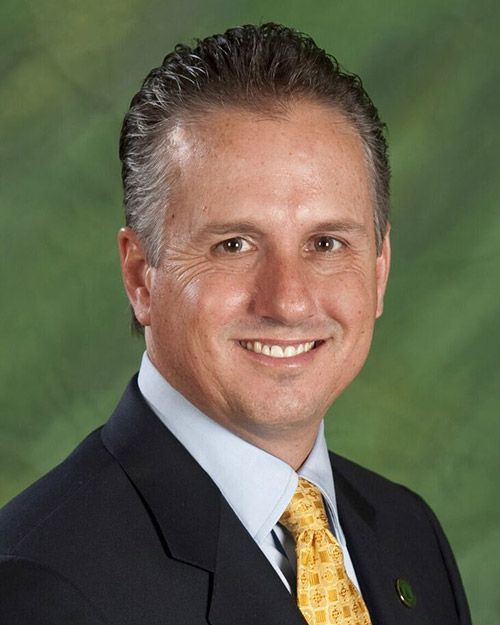
‘We did a lot to immediately support our staff, officials, members, and community.’
Brett Martinez
Members need money
Unexpected expenses hit everyone affected by a disaster. When evacuation orders were lifted, Carn says many Keys Federal members who spent their savings on unexpected travel returned to learn they didn’t have homes or jobs.
Credit unions took many steps to ensure members’ financial survival, such as:
- Offering relief from loan payments, including credit cards and mortgages. “Skip a payment” programs remained available for months at some credit unions.
- Allowing cash withdrawals even when account balances could not be confirmed.
- Providing access to unsecured loans at a set interest rate regardless of credit score, with guidelines favoring approval.
- Suspending late fees, loan processing fees, overdraft fees, transfer fees, early certificate redemption fees, and others, sometimes for two to three months.
- Waiving and/or reimbursing foreign ATM fees.
Disasters disrupt cash deliveries, yet demand for cash was high. Credit unions and banks outside disaster areas stepped in, with some credit union executives delivering cash themselves.
The cooperative spirit works
Credit unions nationwide offered “amazing” support amid back-to-back disasters, says Lacey Yasick, communications manager at the National Credit Union Foundation.
Credit union organizations donated more than $1.7 million via CUAid, the online national disaster relief platform for credit unions, for people affected by Hurricane Harvey in Texas. Gifts of another $1.1 million provided relief for Hurricanes Irma and Maria, and California wildfires.
The Foundation distributed grants from CUAid donations to more than 2,500 credit union people affected by these four disasters. “Credit unions and staff were reaching out to us left and right to see how they could help and what they could do,” Yasick says.
“People helping people” happened locally, too. Juli Lewis, director of the Southeastern Credit Union Foundation that serves the League of Southeastern Credit Unions and Affiliates, received assistance after a generator between her home and detached garage exploded and burned both structures, killing her family’s two dogs. Lewis, her husband, and their daughter were not at home.
Within an hour after Lewis came home to a house on fire, a credit union booked a week’s hotel stay for her family, and another offered space to replace her home-based office. Employees dropped off clothes. A credit union executive offered to board her horse and two donkeys. “This truly showed me the cooperative spirit,” Lewis says.
The Southeastern Foundation disbursed $130,000 to 262 credit union staff and volunteers at 17 credit unions affected by the hurricane. It awarded grants in three phases timed to identify and aid credit union employees and volunteers who did not get assistance from insurance or other sources.
In Southeast Texas, the Cornerstone Credit Union Foundation and CUAid together spent $2.1 million on 1,329 grants in Phase I and $909,000 on 318 grants in Phase II of recovery.
Video: Stand by staff during a disaster
Redwood Credit Union is one example of a credit union that worked to assist its employees and community during natural disasters in 2017.
Give back
Even employees at credit unions in disaster zones found ways to give. Mobiloil Federal employees sold “Texas Strong” T-shirts to raise more than $2,000 for local relief.
Redwood Credit Union worked with the local newspaper, The Press Democrat, and State Sen. Mike McGuire to gather and distribute more than $32 million in donations in 120 days to the North Bay Fire Relief Fund, which is part of the Redwood Credit Union Community Fund.
Redwood paid the fund’s administrative costs so all donations gathered from 41,000 donors in all 50 states and 23 countries could go to disaster relief, including:
- $20 million that helped approximately 8,000 people who lost homes or experienced economic hardship.
- $9.5 million to support nonprofits that provided services and support for fire survivors’ immediate needs.
- $1 million for small businesses affected by the fires.
- $929,000 for fire survivors’ health and well-being.
Rebuilding branches also supported recovery efforts. PenFed Credit Union in McLean, Va., plans to deepen its investment in Puerto Rico when it breaks ground in late 2018 on a new branch expected to bring $4 million to the local economy.
The $23 billion asset credit union boosted morale and drew attention to the need for ongoing support for Puerto Rico by sponsoring a March 2018 benefit concert by Gary Sinise and the Lt. Dan Band on the island, with support from the Gary Sinise Foundation and American Airlines. PenFed also provided a disaster relief package for employees consisting of cash, prepackaged meals, and generators.
The New York Credit Union Foundation has also provided ongoing assistance to Hurricane Maria victims.
Respond quickly
With little warning, a rainy weekend on the Hawaiian island of Kauai in April turned into a deluge that washed out the main road connecting Kauai communities, took down power and communications, and flooded homes. In Hanalei, four feet of water fell in 24 hours.
Kauai Government Employees Federal Credit Union (KGEFCU) CEO Monica Belz used her background in coordinating disaster responses to identify supplies the $115 million asset credit union could gather and deliver to people in need. Gasoline to refuel boats and jet skis used in water rescues was in great need.
The credit union’s staff mobilized from its Lihue office to gather and deliver filled gas cans and other supplies in personal trucks. Armed with a “dry bag” filled with electronic devices and forms, Belz used boats and jet skis, and then hiked to where people needed assistance in areas cut off by the flood.
KGEFCU staff set up a “remote intake location” to add new members and process loan applications at a local community center. If members needed new plastic cards, staff returned the next day to deliver them. KGEFCU also offered no interest on credit card purchases for six months and created a disaster recovery loan of up to $15,000 at 5% interest for most credit tiers, with payments deferred for five months.
KGEFCU added dozens of new members who needed immediate disaster relief loans, while serving current members and staying focused on community needs. “Every day the needs changed,” Belz says. “It started with life and death and rescues, and then it went to power banks to establish communication.”
Recovery takes longer than the headlines
Deposits flowed into credit unions in disaster-stricken areas from insurance payments and federal assistance. Those funds flow back out as people rebuild.
Meanwhile, credit unions keep working to improve business continuity planning. The Southeastern Credit Union Foundation held a disaster preparedness conference to help credit unions create continuity plans. Keys Federal plans to provide ongoing pre-disaster education for members. Carn says the credit union now encourages members to keep a supply of checks on hand so they have access to funds and routing numbers when the next storm hits.
“This gave us all a good reality shot of what can happen,” she says.
At press time: Learn how the eruption of Kilauea is affecting the island of Hawaii at news.cuna.org.
Resources
- CUNA Business Continuity Planning Workshop: cuna.org/learn
- Agility Recovery, a CUNA Strategic Services alliance provider: agilityrecovery.com
- National Credit Union Foundation: ncuf.coop
